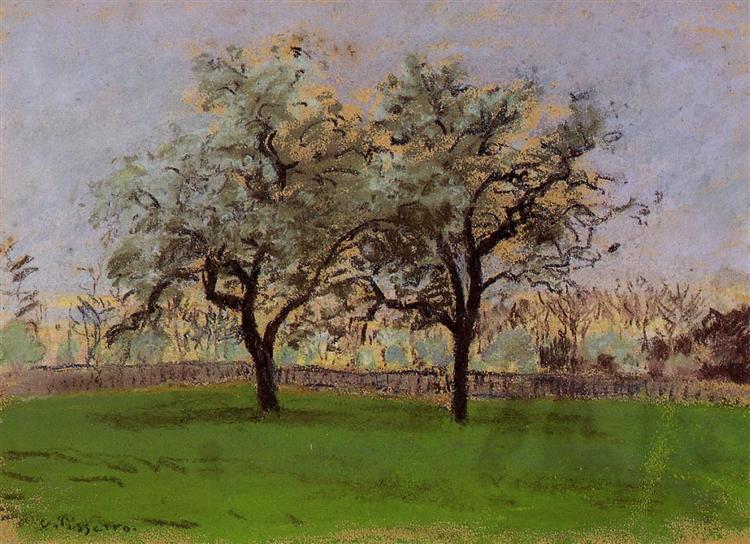描述
Camille Pissarro's Apple Trees at Pontoise (1872) is a fascinating depiction of nature and a prime example of the Impressionist approach that characterized much of his work. A pioneer of the movement, Pissarro was able to capture the ephemeral essence of light and color, elements that intertwine to create a vibrant, life-filled landscape. In this painting, the viewer is greeted by a pastoral scene depicting a group of apple trees in full bloom, surrounded by a natural setting that invites contemplation.
The composition is organised around the trees, which are the main focus of the work. These apple trees, with their lush foliage and branches laden with fruit, create an almost triangular structure that guides the viewer's gaze towards the background of the painting. In the background, a wider landscape can be glimpsed, marked by gentle hills and a beautiful luminosity emanating from the sky. This compositional technique is one of Pissarro's distinctive characteristics, as he managed to integrate the foreground and background in a way that gave depth and dynamism to his landscapes. It is remarkable how he uses the diagonal of the branches and the focus on the light to draw attention towards the horizon, where nature merges in a soft play of colours.
The use of colour in “Apple Trees at Pontoise” is another aspect worth highlighting. Pissarro employs a vibrant and fresh palette, composed of greens, yellows and hints of pink, evoking spring and the renewal of life. The technique of loose brushstrokes and the layered application of colour allows the light to reflect effectively, creating an almost ethereal effect. This treatment of colour and light not only defines the atmosphere of the work, but also triggers an emotional response in the viewer. It becomes a visual experience that transcends the literal representation of the apple trees, inviting connection with nature and its beauty.
It is interesting to note that in this painting, Pissarro chooses not to include human figures, which highlights the supremacy of nature in the painting. However, his choice of a rural landscape full of life suggests human presence through the cultivation and care of the trees. It is a reminder of the balance between the human and the natural, a theme that would resonate in many of his later works.
A contemporary of artists such as Claude Monet and Paul Cézanne, Pissarro used his distinctive style to translate everyday experiences into a vibrant new visual language. Apple Trees at Pontoise is set at a stage in his career when he was establishing himself as a leader of Impressionism, exploring and experimenting with the perception of light and its interaction with color.
In conclusion, “Apple Trees at Pontoise” is not only a work that captures a specific moment in time, but also invites viewers to connect their own experiences with the visual richness of the French countryside. Pissarro’s mastery in utilizing color, composition, and depicting nature without direct human intervention speaks to a deep appreciation for the natural world and its cycles. Through this work, the artist reminds us of the beauty that lies in the everyday, transforming simple apple trees into a sublime spectacle of color and light.
KUADROS ©, a famous painting on your wall.
Hand-made oil painting reproductions, with the quality of professional artists and the distinctive seal of KUADROS ©.
Painting reproduction service with satisfaction guarantee. If you are not completely satisfied with the replica of your painting, we will refund 100% of your money.

